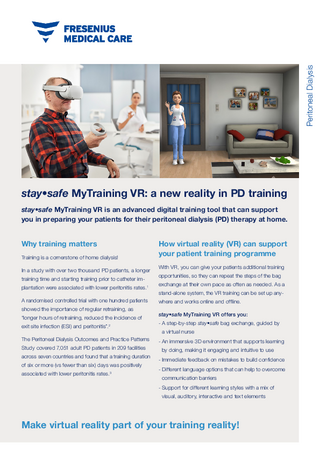Fresenius Medical Care offers fluids for Peritoneal Dialysis and practical ways to assess and correct fluid status.
Virtual reality training
In a study with over 2,000 PD patients by Figueiredo et al. in 2015, a longer training time and starting training prior to catheter implantation were associated with lower peritonitis rates.1
In 2018, a randomized controlled trial with 100 patients by Chang et al. showed the importance of regular retraining, as “[…] longer hours of retraining reduced the incidence of exit site infection (ESI) and peritonitis”2
The Peritoneal Dialysis Outcomes and Practice Patterns Study published in 2020 by Perl et al. covered 7,051 adult PD patients in 209 facilities across 7 countries and found that training duration of 6 or more (vs <6) days was positively associated with lower peritonitis rates.3
How to include stay•safe Training VR in your training concept
The stay•safe MyTraining VR supports you in teaching CAPD to dialysis patients, caretakers and other health care professionals. It cannot replace a full, hands-on patient training by a trained professional and it is not intended to do so. It is a training tool just like any brochure, video, website or training apron you may use to teach your patient. As such, stay•safe MyTraining VR can help…
How to learn more
The stay•safe MyTraining VR is currently only available in a limited number of countries. Please contact your local Fresenius Medical Care representative to find out more.
Flyer for download

stay•safe
MyTraining VR
Terms & Conditions

Stay•Safe MyTraining VR EMEA version - Terms & Conditions
PDF, 245 KB
Privacy Notice Stay•Safe MyTraining VR
PDF, 166 KB







